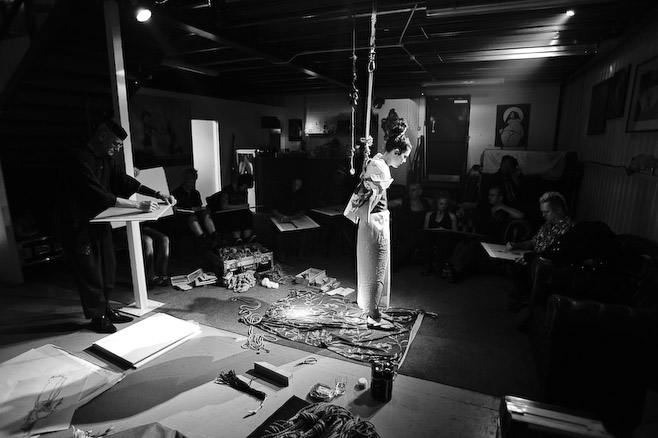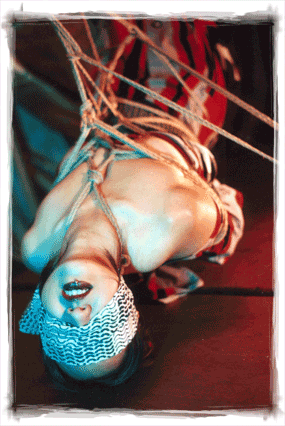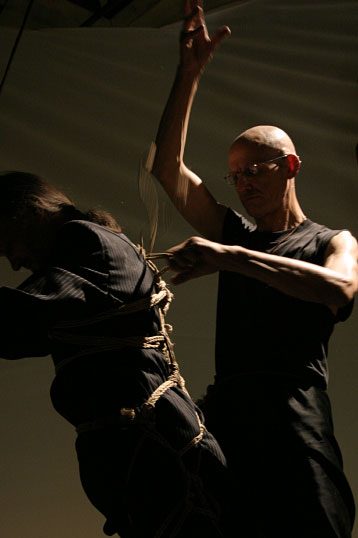
Nawashi Murakawa
His Workshops:
Language: English
For 6 years, in the late '80s, early '90s period, I had the pleasure of living with a Japanese girl. My relationship with her changed my life considerably. It brought about a new cultural understanding and a new way of looking at everything. In my core 'job' as an illustrator (I have been illustrating for over 38 years now), I do black and white woodcuts and engravings, which involve very detailed line technique. When my Japanese girlfriend and I eventually parted, I was left with special yearnings and feelings. Although my Japanese girlfriend and I had never been involved in rope bondage, something new had been awakened within me, something which was deeply spiritual and aesthetic. No-one had ever shown me anything to do with this subject of rope bondage, but I felt I suddenly had an empathy, not just with bondage, but with many other areas of the traditional Japanese culture. I didn't know which kinds of rope to use, which rope techniques to use, where to buy materials, or even where to start. I just sat down and started to tie a chair. I suppose I saw the chair as being like a human being - the legs, the back of the chair... you can relate those to parts of the human body. After that, I tried tying myself. At first, I tried very simple things. I knew I would understand this whole subject, this 'knowledge', with no-one to teach me, so I just persevered by myself. I could see the endless creative possibilities of Japanese rope bondage, There are no limits to the positions and variations of the work.
My job as a b/w line illustrator means I define and draw things in a linear way. I am using a pen on paper. With Japanese rope bondage, I am using rope on the body. One is lines on paper. The other is lines on the body. Once you have developed some skills and have understood the special aesthetic of the subject, you realise how strict the rules are, but at the same time, you are totally free to create complex situations. I feel I am very lucky to have found this understanding. Having worked in Japan, I also feel very honoured to have been accepted by some of the best Nawashi and they are amazed that I have managed to understand one of their traditions without teaching, in a master and apprentice situation. I have, found my way, my own own style, by myself. In a sense, I suppose I am the far western outpost of a special Japanese underground subculture.
I have visited Japan on numerous occasions. Amongst these, in October 2000, I spent nearly a month there, accompanied by Mistress Leona. The main objective of this trip was to build upon my visit of 1998, where I was first introduced to some very special people. I feel that, in those intervening two years, my skills and understanding had developed, as they continue to do today. I was keen to learn more from just being there... you learn from just being in Japan, especially being surrounded by traditional Japanese feeling. You assimilate the essence. Our small, traditional-style, 6 mat room in Shibuya, had this feeling - on the floor, 6 tatami mats... 2 low futon beds... traditional Japanese lavatory, where you squat and aim... the structure fashioned from paper and wood, with sliding shoji doors... the muted and natural colours of everything and, on the low table, always the green tea set. This was a very small, traditional, family run hotel. Run by two generations of the same family, this place was perfect for my requirements and was later used for a photo session.
My feelings for Japan are not for the ultra-modern, almost psychedelic, world which appeals to most younger people. When you come out of Shibuya station (Tokyo), your senses are assailed by a barrage of multi-media video screens, neon, a cachophany of sound... its the madness of Japanese youth. There are so many people around you who seem to look just the same, like ants in an ant hill. My interests in Kinbaku have come from a dedicated interest in traditional Japanese culture, in which there is a special spirituality and care. Rope bondage is linked to so many Japanese concepts and ideas, even religion (Shinto). It is a vision of nature controlled. This is seen in the Japanese garden, where every tree is carefully clipped and shaped, often with the use of rope and bamboo sticks, as it also is in Bonsai.
The kimono is bondage - just look how Japanese women walk, even when they are not wearing a kimono. They have an elegant, slightly 'pigeon-toed' walk, where the foot is never taken far from the ground. This is directly related to the hobbling effect of the kimono. Bondage is seen in food presentation, where food is tied together in parcels and exquisitely presented. The traditional Bentoh Box (lunch box) was tied in a 'kerchief to carry the food inside and even today, people still do this. Again, the Furoshiki is a traditional Japanese bag made from a piece of cloth about a yard square, which usually contains folded kimono and accessories. It is so simple! Around the waist, over the kimono, is a wide sash called an obé. This is made from very stiff, heavy silk and is usually about ten or twelve feet long and is wound around the waist at least twice and tied with wonderful, decorative bows at the back. There are many variations. Over this, there is a rope called the obé-domé, which is tied in a reef knot at the front. The woman's body is flattened and it keeps her posture erect. The erotic emphasis is transferred especially to the back of the neck and hands. No other skin is visible. There is no emphasis on the bust or the waist. It is all about elegance and control.
I especially enjoy working with women in kimono, to create a very authentic style of rope bondage (even the feet show great feeling!) and it was a great honour for me, in October last year, to work with two women wearing traditional kimono and to make photo sessions with them. Having worked with Japanese women in London, making kinbaku in Japan was even more special, because of the magic of the whole place. The Japanese physique is ideally suited to very creative rope work. Japanese women have smaller frames, with shorter legs and shorter arms to reduce the centre of gravity. They also have exceptionally strong skin and hair. It is possible to tie the hair of a Japanese woman into the work and, if done correctly, the hair can even support body weight, In the West, I try to create the essence of this traditional Japanese artform with the very different shape of the western body. No matter what shape, size, weight or sex people are, my higher purpose is to give them elegance, dignity and a unique experience. Nawashi Murakawa is an extremely experienced practitioner of the art of Kinbaku and has been been working with this traditional Japanese skill for many years. This article is not meant for instruction. It is purely a guide to the aesthetic appreciation and background of one of the most beautiful of Japanese traditions.
Salon of Kinbaku

Respected British artist, performer and rope bondage specialist Nawashi Murakawa takes you on a journey of very traditional Japanese rope bondage or ‘Kinbaku’, in the form of an instructional life drawing salon.
Here you can experience, in a intimate environment, a truly unique master-class where you can capture, in the medium of your choice, a wonderful variety of traditional ‘Kinbaku’ positions as beautifully demonstrated by Nawashi’s ‘M-jo’ or model.
Everyone of all levels of ability can enjoy and benefit from the years of practical illustration and rope bondage experience from Murakawa.
Paper and charcoal is provided for all or you can bring your own drawing mediums.
Photography is permitted under the guidance of Murakawa at various times throughout the evening.
Japanese Bondage - The Cultural Context

Nawashi Murakawa’s interests in Kinbaku have come from a dedicated interest in traditional Japanese culture, in which there is a special spirituality and care. Rope bondage is linked to many Japanese concepts and ideas, even religion (Shinto). It is a vision of nature controlled.
Nawashi Murakawa talks very vivid and inspiring about his passion for Kinbaku and his many journeys to Japan. He will depict some forms and principles of traditional japanese culture and answer your questions. Not just for rope freaks!!!


